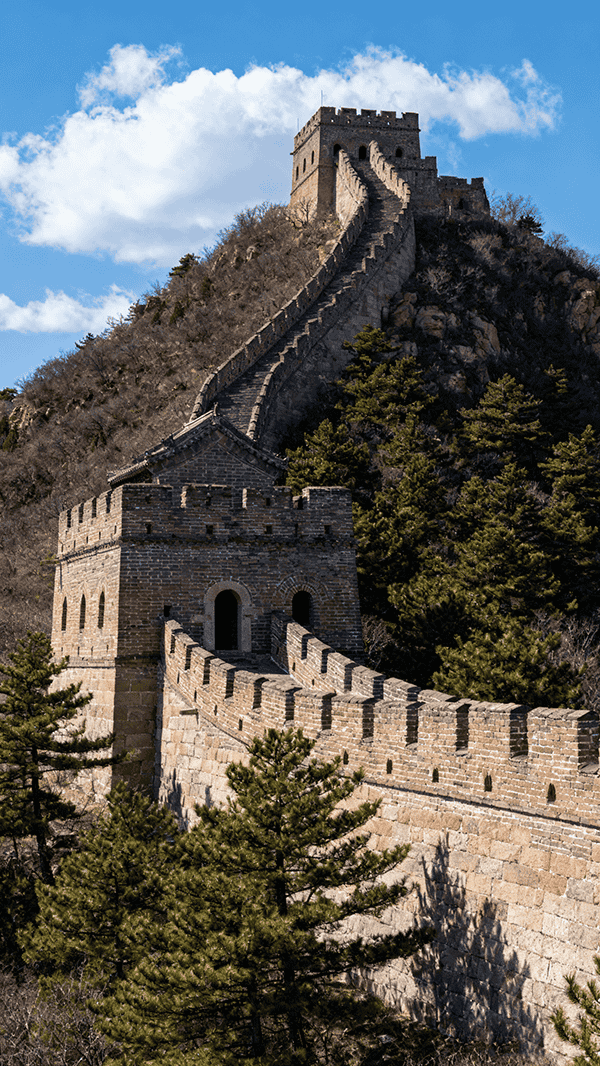Amidst the mountains of Beijing, a majestic “giant dragon” winds its way—crossing ridges, traversing valleys, and standing tall despite centuries of wind and rain: this is the Great Wall of Beijing. As a core section of the Great Wall of China, it is not only an outstanding example of ancient military defense engineering but also carries the profound history of the Chinese nation resisting foreign invasions and guarding their homeland. It has become a cultural symbol of global significance.
The construction of the Beijing section of the Great Wall can be traced back to the Spring and Autumn and Warring States periods, when the State of Yan built the earliest sections to defend against northern nomadic tribes. Subsequent dynasties, including the Qin, Han, Northern Wei, and Northern Qi, conducted repairs and expansions. However, the main structure of the Great Wall as we see it today in Beijing was largely built during the Ming Dynasty. After the establishment of the Ming Dynasty, to guard against Mongol incursions, the construction of the Great Wall reached its peak. In the Beijing area alone, dozens of sections such as Huanghuacheng, Mutianyu, Simatai, and Badaling were built, forming a crucial part of the “Nine Defense Garrisons” system. The total length of the Great Wall in Beijing exceeds 600 kilometers, standing like a solid barrier protecting the capital region.
Among the many sections of the Great Wall in Beijing, Badaling and Mutianyu are the most renowned. Badaling, located in Yanqing District at the northern pass of the Jundu Mountain valley, is celebrated as one of the “Nine Fortresses under Heaven” due to its strategic terrain and expansive views. Here, the wall averages 7.8 meters in height and 5 meters in width at the top, wide enough for five horses or ten people to walk abreast. Its exterior features crenellations, lookout holes, and arrow ports, while the interior has parapets and horse passages, showcasing exquisite offensive and defensive design. Watchtowers at Badaling are densely spaced, approximately every 500 meters. These two-story towers allowed sentries to watch and shoot from the upper level, while the lower level housed soldiers and stored supplies, reflecting the meticulous layout of ancient military architecture. As the most well-preserved and earliest opened section of the Ming Great Wall, Badaling has become the top choice for visitors from China and abroad. Climbing the wall and gazing at the mountains, one can almost hear the echoes of history in the valleys.
Mutianyu Great Wall, situated in Huairou District, is known for blending “beauty” and “precipitousness.” Unlike the open vistas of Badaling, Mutianyu follows the dramatic contours of the mountains, with some slopes as steep as 70 degrees, offering a more challenging climb. The gentler sections are shaded by lush forests, adorned with blooming apricot blossoms in spring and vibrant red leaves in autumn, creating breathtaking scenery. A unique feature of Mutianyu is its “double-sided crenellations”—while most sections only have crenellations on the outer side, Mutianyu has them on both sides. This design stems from its location northeast of Beijing, requiring defense against threats from both northern nomadic tribes and the eastern Liaodong region, exemplifying the ancient military strategists’ wisdom of adapting to local conditions. Furthermore, the watchtowers at Mutianyu come in various shapes—square, round, and flat. Among them, the “Zhengguantai” watchtower, composed of three interconnected towers, is uniquely shaped and considered a masterpiece of Great Wall architecture.
Beyond its military function, the architectural details of the Beijing Great Wall are rich in cultural significance. The walls were primarily constructed using local stone or gray bricks, bound with a mortar made from sticky rice soup, lime, and loess. This “sticky rice mortar” was exceptionally strong, enabling the walls to remain solid despite centuries of weathering. The numbering on watchtowers and inscriptions on bricks not only served as records for construction management but have also become valuable historical materials for studying the Ming Dynasty’s military system and social conditions. The beacon towers along the Wall, functioning as ancient “information relay stations,” could transmit signals about enemy movements over vast distances in a short time using varying numbers and sequences of smoke signals—an efficient communication system akin to an ancient “military telegraph.”
In 1987, the Great Wall was inscribed on the UNESCO World Heritage List. As a core component, the Beijing section was recognized with the evaluation: “The value of the Great Wall in architectural history lies in it being the most extensive military defense project in human history. Its construction scale, technical level, and cultural significance all represent the pinnacle of ancient defensive architecture.” Today, the Beijing Great Wall no longer serves as a military barrier but has become a bridge connecting Chinese and global cultures. Every year, millions of visitors are drawn here—some to hike and experience its grandeur, others to participate in cultural activities and learn its history. From the heroic vow that “He who has never been to the Great Wall is not a true man,” to the resilience and unity symbolized by the “Spirit of the Great Wall,” the Beijing Great Wall continues to narrate the past, present, and future of the Chinese nation.
This “Eastern Giant Dragon” winding through the mountains is not merely an architectural marvel but an epic carved in stone and brick. It has witnessed dynastic changes and the passage of time, and it will continue to embody the cultural confidence of the Chinese nation, radiating new brilliance in the new era.
